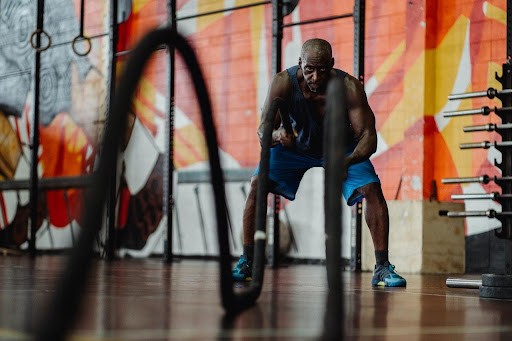You’ve probably witnessed someone in the gym slamming thick heavy ropes in a chaotic way. That’s called a battle rope, and it’s one of the best ways to burn calories and build strength in your arms, back, core, and legs, and it’s also a lot of fun.- Battle Rope Exercises
When you’re looking from the outside, it feels relatively easy. But you’re going to be amazed at how difficult it is to handle more than 10 seconds of intense slamming. There are a few exercises that you can try to feel the advantages of combat rope workouts and decide whether to include in your fitness program. Click on this link to read more.
Wave slams – Battle Rope Exercises
The best way to try out these exercises is in a gym that already has the equipment. It’s best to start with a rope that’s short and not too thick. As your strength increases, you can experiment with longer lengths and thicker gauges. Once you decide on the perfect one, it’s time to get started.
Position yourself with your feet apart, close to your shoulder length. You should be able to do a deep squat in that position and hold one rope in each hand. There should be a little bit of slack in the ropes, so you can have some room to maneuver.
Engage your core by bending your knees slightly and having a friend to measure time for you. The movement should start with you raising both hands above your shoulders at the same time and then slamming the rope into the ground.
You’re going to notice a wave-like movement from the rope. Raise and slam again, and try to do the movement with more power and speed. Don’t pause for ten seconds, and see how you feel. You’re probably going to feel out of breath after your first try. Wait for a full minute, and try doing it again. Follow this page for more info https://www.boxrox.com/how-to-get-stronger-fitter-battle-rope/.
Unilateral waves – Battle Rope Exercises

This exercise is pretty similar to the first one, with one small change. Use the same stance with both feet being shoulder-width apart. The same thing goes for the light knee bend. However, when you start the movement, don’t use both hands to strike the rope on the ground at the same time.
Instead, raise one hand while you slam with the other one. This way, the ropes will be traveling in the opposite direction of each other. In the first exercise, you’ll be working your lower back more than your upper back. By doing unilateral waves, you’ll be more focused on your upper back since there is more movement from your lats.
Circles – Battle Rope Exercises
Here, you can do alternating large and little circles, depending on how you want your workout to be structured. The stance is the same as in the previous two exercises, but the movement is different. Instead of raising your hands up and down, you’ll be moving them in circles.
You can do it with one hand after the other or both at the same time. This exercise can’t be performed with the same intensity and speed as the previous ones, which is why 30 seconds is a recommended time for beginning.
A few tips to remember
First and foremost, you need to perfect your form. If you have a personal trainer, they’re going to correct your form while you’re doing the movements. If you’re alone, set up your phone camera to record you while you’re doing the movements, or try to look at yourself in the mirror.
Don’t increase the intensity or the pace of battle ropes exercises before you master the form because that could cause an injury. This exercise is a lot of fun, which makes a lot of people go all out on it. But that could lead to a shoulder or lower back injury if you don’t use the correct technique.
As soon as you master the form, feel free to experiment with different moves. The equipment is versatile and adaptable, which means that you can move in a variety of directions. This allows you to work out different muscle groups.
Finally, you can choose to get a heavier or longer rope which is going to be even more challenging. The distance between you and the anchor determines how difficult the exercise is going to be. Always remember to keep your core engaged, which will ensure you are completing the motions in a safe and appropriate manner.













